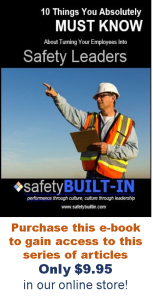
 In our previous issue, as part of our S.E.A.T. safety coaching method, we looked at how to engage an employee in a conversation who is involved in an unsafe situation. And there we saw the importance of connecting the dots between that behavior and the safety-culture goals of the company, as well as the personal consequences of that behavior. Remember, the S.E.A.T. method stands for:
In our previous issue, as part of our S.E.A.T. safety coaching method, we looked at how to engage an employee in a conversation who is involved in an unsafe situation. And there we saw the importance of connecting the dots between that behavior and the safety-culture goals of the company, as well as the personal consequences of that behavior. Remember, the S.E.A.T. method stands for:
“Stop the action” “Engage the employee” “get Agreement” “Thank them”
Before we bring the conversation to a close, we need to offer some kind of internal motivation to the employee not to engage in this or any other unsafe behavior in the future. The best way to do that is to make an appeal to a common core value; and the most common of core values is family, friends, and their relationships with the people they care about and who care about them. Now, if you know the employee well, then you may also know something about his or her family and friends, and how they spend time together. If so, appeal to that: “John, I know you like playing ball with your kids. How do you think it would impact them if you got hurt in such a way that you couldn’t do that any more?” If you don’t know the employee that well, then appeal to your own situation and let them connect the dots: “John, I know if I were in an unsafe situation, I’d want someone to stop me and make me aware of it, and I know my family would want that as well.” And be sure to bring them on board with helping to lead a safety culture: “As you know, John, we’re all safety leaders here, and we need each other’s help to make sure everyone gets home safely.” We have two more steps before this conversation is finished; but we’ll save those for the next issue. That’s it for this edition of Recordable INSIGHTS. We’ll see you next time. ~ES
